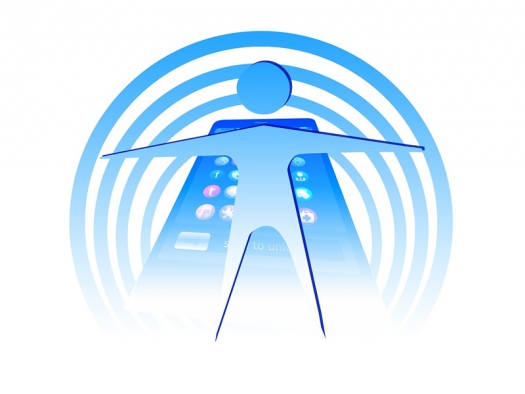electromagneticrays.jpg

Image by geralt, 2013 / Pixabay License
Of the many lectures I give, the one that elicits the most disbelief from my audiences is about the potential health dangers posed by wireless frequencies. The resistance to this message comes from the fact that it's an inconvenient warning about conveniences (think cell phones and cordless phones) that have become thoroughly incorporated into modern life. But the reality, convenient or not, is that such technologies aren't totally safe – at least not for everybody.
The American Academy of Environmental Medicine, an international association of physicians and other professionals who specialize in how environmental factors affect health, has noted the troubling downside to modern communication technology. In a recent statement, the organization recognized that some patients "are being adversely impacted" by electromagnetic frequency (EMF, the fields emitted from household wiring and appliances) and radio frequency (RF, the fields emitted by microwaves and wireless technology). Such people, the association says, are "becoming more electromagnetically sensitive." Furthermore, such exposure "may be an underlying cause of a patient's disease."
William Rea, M.D., who coauthored the association's position paper, first reported on EMF sensitivity back in 1991. Since then research suggests a troubling connection between man-made electrical field exposure and a variety of medical disorders and symptoms that include neurological conditions such as depression; dizziness; tingling, burning, itching, and numbness in the skin; musculoskeletal pain and spasm; pulmonary issues such as chest tightness and shortness of breath; nausea; burning eyes; pressure in ears; tooth pain; and heart disease and vascular effects such as arrhythmias, racing heart, and edema.
Cardiology concerns
While most cardiologists are not aware of the impact environmental electromagnetic and wireless frequencies can have on heart function, it is a subject that has long concerned me. That's because living beings are conglomerates of electromagnetic energy. Our cells transmit and receive energy as part of their fundamental activities and outside frequencies can certainly interfere with these functions. A prime example is the story told to me recently by cardiologist Lee Cowden, M.D.
In 2005, Cowden moved to Arizona and had a wireless Internet system set up in his house. A short while after the computer installer left, his wife told him her heart had started to skip beats. Cowden checked her and found that she was in atrial fibrillation, meaning that her heartbeat had become irregular. It's a common cardiac arrhythmia but it can be potentially dangerous. Suspecting that the wireless system could have something to do with the problem, Lee turned it off. His wife's heartbeat returned to normal. A bit later that day, he turned the system back on and his wife experienced atrial fibrillation again.
Fast forward to 2012. Cowden and his wife rented a home in rural North Texas that was equipped with a smart meter. Using a high-frequency detector, Cowden determined that the meter was emitting a signal to the power company only once every 60 minutes. He thought he could live with it, even though his desk was just 15 feet from the meter. But then he awoke one morning with fever, chills, and coughing up yellow sputum after having spent many hours working at his desk the night before. When he checked the smart meter again he found it was now sending signals every minute – a 60-fold increase.
At the same time, his wife, for the first time since 2005, complained of palpitations. Later in the day, Lee also felt his heart beating irregularly.
Being very knowledgeable and resourceful, Cowden erected a special canopy over their beds designed to shield out RF and EMF fields. Under this canopy they were able to restore a normal heartbeat. When they left the bed, however, the irregularity returned. Finally, after moving out temporarily and having a different power company ultimately replace the offending smart meter, Cowden and his wife are "feeling great."
Cowden's story didn't surprise me, as my eldest son Step developed multiple, serious health problems, and almost died, because of a very stressful lifestyle that included exposure to intense EMF and RF fields when he worked as a day trader in Manhattan. Happily, he recovered and has rebounded robustly, but he still shies away from wireless technology as much as possible.
Fact not fiction
To be sure, these are anecdotes. But there are more and more surfacing all the time and being documented by savvy doctors, which is one reason why the American Academy of Environmental Medicine issued its warning. In my own research, I have seen reports going back decades describing symptoms of headache, fatigue, insomnia, and accelerated heartbeat. More recently there have been several reports of apparent associations between cardiac arrest and wireless systems placed in Canadian schools.
The research indicates that wireless frequencies can disturb cellular communication, cause oxidative stress in the body, and even thicken the blood. Clearly, thorough research is needed to determine the people most at risk when exposed to EMF and RF fields. Until there is a precise scientific assessment, however, you can take the following steps to help protect yourself:
- Limit cell phone use. Use your cell phone as little as possible and, when you do, use the speakerphone feature to keep it away from your head. If you don't need to hold it at all, just place it on a table. And don't carry it your pockets.
- Toss your cordless phones. At home, go back to corded phones attached to a land line.
- Supplement. Taking CoQ10 (100 to 200 mg), fish or squid oil (1 to 2 g), vitamin C (500 to 1,000 mg), and melatonin (.5 to 10 mg) daily can help protect you from oxidative damage and bolster your autonomic nervous system and your heart rate variability (HRV).
- Ground yourself. Earthing (the practice of reconnecting with the Earth either by going barefoot outside or sitting or lying on special conductive devices) is a magnificent way to protect your body from the potential damage of electric fields. It upholds healthy HRV, reduces inflammation, and improves blood viscosity.
- Refuse a smart meter. Check whether your electric company has installed, or is planning to install, smart meters. Then tell them firmly you don't want one. This is especially important if you suddenly develop arrhythmias or problems sleeping at night and your cardiologist can't determine the cause. The Environmental Medical Association strongly recommends removal of these meters from the homes of patients who may be harmed by the wireless emissions.
Reference
American Academy of Environmental Medicine Recommendations Regarding Electromagnetic and Radiofrequency Exposure. Accessed September 10, 2012.
Originally published October 2012 in Heart, Health & Nutrition. Used with permission.


